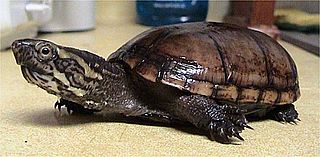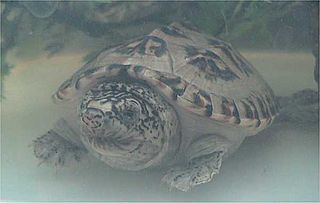
The Kinosternidae are a family of mostly small turtles that includes the mud turtles and musk turtles. The family contains 25 species within four genera, but taxonomic reclassification is an ongoing process, so many sources vary on the exact numbers of species and subspecies. They inhabit slow-moving bodies of water, often with soft, muddy bottoms and abundant vegetation.

Kinosternon is a genus of small aquatic turtles from the Americas known commonly as mud turtles.

Sternotherus is a genus of turtles in the family Kinosternidae including six species commonly known as musk turtles. The genus is endemic to North America, occurring in the eastern third of the US and southeast Ontario, Canada. Musk glands positioned near the bridge of the shell can produce foul smelling secretions when the turtles are threatened, although gentle handling does not normally provoke a response. Sternotherus are moderately small turtles, with the largest species in the genus, the razor-backed musk turtle, attaining a maximum of 17.6 cm. in shell length. The carapace is characteristically oval and domed, with most species having one or three keels on the back which may become smoother and obscure with age in some species. Musk turtles are generally drab in color, mostly black, gray, brown, olive, or ocher, which aid in camouflaging them in their natural habitats. The head is relatively large and stout, marked with spots, streaks, or strips. The plastron has only 10 or 11 scutes, as opposed to 12, a more common condition in North American turtles. The tail is short, with males having a horny claw like tip.

The razor-backed musk turtle is a species of turtle in the family Kinosternidae. The species is native to the southern United States. There are no subspecies that are recognized as being valid.

The yellow mud turtle, also commonly known as the yellow-necked mud turtle, is a species of mud turtle in the family Kinosternidae. The species is endemic to the Central United States and Mexico.

Creaser's mud turtle is a species of mud turtle in the family Kinosternidae. The species is endemic to the Yucatán Peninsula in southeastern Mexico.
Dunn's mud turtle, also known commonly as the Colombian mud turtle, is a species of turtle in the family Kinosternidae.

The Oaxaca mud turtle is a species of mud turtle in the family Kinosternidae. It is endemic to Mexico. Both the common name and the scientific name derive from Oaxaca, a Mexican state. The International Union for Conservation of Nature has rated this species as "data deficient" as there is insufficient information available to judge its conservation status.

The Sonora mud turtle, also known as the Sonoyta mud turtle, is a species of turtle in the Kinosternidae family. It is found in Mexico and the United States.

The Mexican musk turtle, also known commonly as the giant musk turtle, is a species of turtle in the family Kinosternidae. The species occurs in Central America and Mexico.

The eastern mud turtle or common mud turtle is a common species of turtle in the family Kinosternidae. The species is endemic to the United States. There are two recognized subspecies.

The striped mud turtle is a species of turtle in the family Kinosternidae. The species is native to the southeastern United States.
The Alamos mud turtle is a species of mud turtle in the family Kinosternidae. It is endemic to Mexico, where it occurs in the states of Sinaloa and Sonora.

The Arizona mud turtle is a species of mud turtle in the family Kinosternidae found in the deserts of Arizona and Sonora (Mexico). It is a semi-aquatic turtle. It lives in impermanent puddles, and avoids permanent rivers and lakes.
The Jalisco mud turtle is a species of mud turtle in the Kinosternidae family endemic to Mexico. It is found in Colima and Jalisco. They live in freshwater habitats like swamps or quiet rivers. Jalisco mud turtles reproduce oviparous, meaning the eggs hatch after the parent has laid them. Population size is unknown; there have been less than 20 individuals seen in the last twenty years. The mud turtle is said to be adapted to aquatic habitats, meaning that a population decline is then expected due to habitat fragmentation.

The Durango mud turtle is a species of mud turtle in the Kinosternidae family.

The rough-footed mud turtle is a species of mud turtle in the family Kinosternidae. The species is endemic to the southwestern United States and northern Mexico.

The white-lipped mud turtle is a species of mud turtle in the family Kinosternidae. The species is endemic to Central America and northwestern South America.

The scorpion mud turtle or Tabasco mud turtle is a species of mud turtle in the family Kinosternidae. It is found in Mexico, Central and South America.

The Mexican mud turtle, is a species of mud turtle in the family Kinosternidae. Endemic to Mexico, they inhabit moist environments, such as shallow ponds, lakes, rivers or intermediate temp. tropical forest areas.


















